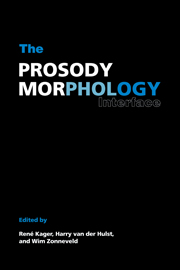Book contents
- Frontmatter
- Contents
- Contributors
- Preface
- 1 Introduction
- 2 On the moraic representation of underlying geminates: evidence from Prosodic Morphology
- 3 Verbal reduplication in three Bantu languages
- 4 Prosodic Morphology and tone: the case of Chichewa
- 5 Exceptional stress-attracting suffixes in Turkish: representations versus the grammar
- 6 Realignment
- 7 Faithfulness and identity in Prosodic Morphology
- 8 Austronesian nasal substitution and other NC effects
- 9 The prosodic base of the Hausa plural
- 10 Prosodic optimality and prefixation in Polish
- 11 Double reduplications in parallel
- Index of subjects
- Index of constraints
- Index of languages
- Index of names
6 - Realignment
Published online by Cambridge University Press: 27 January 2010
- Frontmatter
- Contents
- Contributors
- Preface
- 1 Introduction
- 2 On the moraic representation of underlying geminates: evidence from Prosodic Morphology
- 3 Verbal reduplication in three Bantu languages
- 4 Prosodic Morphology and tone: the case of Chichewa
- 5 Exceptional stress-attracting suffixes in Turkish: representations versus the grammar
- 6 Realignment
- 7 Faithfulness and identity in Prosodic Morphology
- 8 Austronesian nasal substitution and other NC effects
- 9 The prosodic base of the Hausa plural
- 10 Prosodic optimality and prefixation in Polish
- 11 Double reduplications in parallel
- Index of subjects
- Index of constraints
- Index of languages
- Index of names
Summary
Introduction
The notion “alignment” entered Optimality Theory (OT) in the form of correspondence requirements that demand certain edges of grammatical constituents – say, the right edge of every stem – coincide with a corresponding edge of a prosodic constituent – say, with the right edge of some syllable. Alignment requirements control the prosodic shape of morphological and other grammatical constituents and in this way lay the foundation for Prosodic-Morphological analysis. The constraint just mentioned forces the end of a stem to coincide with the end of a syllable: it must be syllabified, and the syllable must not span a stem-suffix juncture. First proposed in Prince and Smolensky (1991, 1993) in the course of an analysis of the Australian language Lardil, this constraint was shown to be operative in Axininca Campa by McCarthy and Prince (1993a). In its concentration on the mapping relation between grammatical and prosodic categories, Alignment Theory has its roots in earlier work on the syntax–prosody interface (most notably the “endbased” theory of Selkirk 1986), extended to word-internal domains in Inkelas (1989) and Cohn (1989). The alignment concept has since been developed in several ways. Thus it has been shown that significant analytical advantages can be obtained by extending alignment to include an altogether different type of constraint linking two prosodic categories like prosodic words and feet: i.e., PCat-PCat constraints, in addition to the traditional GCat-PCat type. The internal prosody of words in Japanese is significantly shaped by the requirement that the left edge of every PrWd must correspond to the left edge of a foot (Itô and Mester 1992: 30). In different theoretical contexts, similar ideas have been explored in work by Burzio (1994) and Idsardi (1992).
- Type
- Chapter
- Information
- The Prosody-Morphology Interface , pp. 188 - 217Publisher: Cambridge University PressPrint publication year: 1999
- 72
- Cited by

